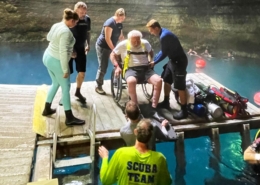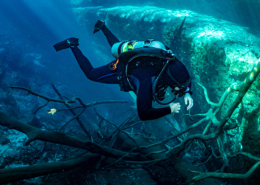
Photo provided by: Aldo Ferrucci
In order to understand how constant PO2 in a closed circuit rebreather differs from diving nitrox, we need a quick refresher on physiology. Our bodies respond to the partial pressure of oxygen (PO2), the gas that we breathe, as opposed to the fraction or percentage of oxygen in the gas. We use the number “16” as a reference to the acceptable safe PO2 range that our bodies can tolerate. If the PO2 of the gas you are breathing falls below .16 ata, you are at risk of losing consciousness due to hypoxia (not enough oxygen to the brain). At a PO2 above 1.6 you begin to run the risk of central nervous system oxygen toxicity for short term exposures or pulmonary oxygen toxicity for longer term exposures. Each of these has very negative side effects. Above water, these situations are manageable. Underwater, however, the result is usually fatal.
So where does PO2 come from, and how does it relate to nitrox and rebreathers? There are two ways to measure the PO2 of a gas. The first, typically used by open circuit nitrox divers, is by taking the fraction of oxygen in the gas and multiplying it by the pressure being exerted on it. For example, we will look at air, which is 21% oxygen, 79% nitrogen. At the surface, air is under 1 atmosphere (ata) of pressure, so the PO2 is .21 ata (fraction of oxygen .21 x 1 ata = .21). Every 10 meters/33 feet, another atmosphere of pressure is exerted. So, if we descend to 10 meters/33 feet on air, our PO2 rises to .42 ata (fraction of oxygen .21 x 2 ata = .42 ata). Using 36% Enriched Air Nitrox as another example, the PO2 on the surface is .36 ata (fraction of oxygen .36 x 1 ata = .36 ata). Descend to 30 meters/99 feet, the PO2 rises to 1.44 (fraction of oxygen .36 x 4 ata = 1.44 ata).
As you can see, if you know the fraction of oxygen in the gas as well as your depth, a little simple math formula (or by using a nitrox capable dive computer or table to do the math for you), and you can easily find your PO2. The other method, which is used by most rebreathers on the market today, is to have an oxygen sensor built into the loop which senses the fraction of oxygen in the gas and does the math for you. This is crucial because fraction of oxygen in a rebreather varies throughout the dive; the machine adds oxygen as necessary to maintain a constant PO2. It’s essentially like diving with a nitrox blending station with you that is constantly making the best gas for whatever depth you are at. Still awake?
Ok, so we know a PO2 below .16 is bad and that a PO2 above 1.6 is bad, so what is a “good” PO2? Well, essentially, the more oxygen we have in the gas we are breathing, the less room there is for inert gasses (nitrogen or helium) for our bodies to absorb and create decompression obligations. While diving nitrox on open circuit, you plan your gas to have the highest allowable PO2 for the deepest portion of the dive in order to reduce the inert gas content as much as possible. This extends your no decompression limit, or reduces your decompression obligations, considerably when compared to diving air.
Unfortunately, because the fraction of oxygen in the gas is constant, your advantage decreases (along with the PO2) as you ascend to shallower depths. This is why technical divers switch to higher fraction of oxygen gasses as they ascend, to regain some of that advantage and reduce their decompression times. A closed circuit rebreather works in the opposite fashion. It keeps the PO2 at a constant “set-point,” usually 1.2 – 1.3 ata, by continuously analyzing the breathing mixture and adding oxygen when necessary. This results in the lowest possible inert gas exposure throughout all phases of the dive, considerably increasing no decompression limits or decreasing decompression obligations. So the perfect PO2 is the one that allows you to maximize your bottom time, minimize your decompression obligation and that stays between the .16 and 1.6 limits. There are other variables that affect the best PO2 at depth such as: current, workload, temperature, etc, but that is for another article.
For more information on PO2’s and rebreathers, check us out at https://www.tdisdi.com/tdi/get-certified/tdi-diver-level-courses/ and search for a dive center or instructor near you.
Contact SDI TDI and ERDI
If you would like more information, please contact our World Headquarters or your Regional Office.
Tel: 888.778.9073 | 207.729.4201
Email: Worldhq@tdisdi.com
Facebook: www.facebook.com/SDITDI









Skriv en kommentar
Vil du deltage i diskussionen ?Du er velkommen til at bidrage !